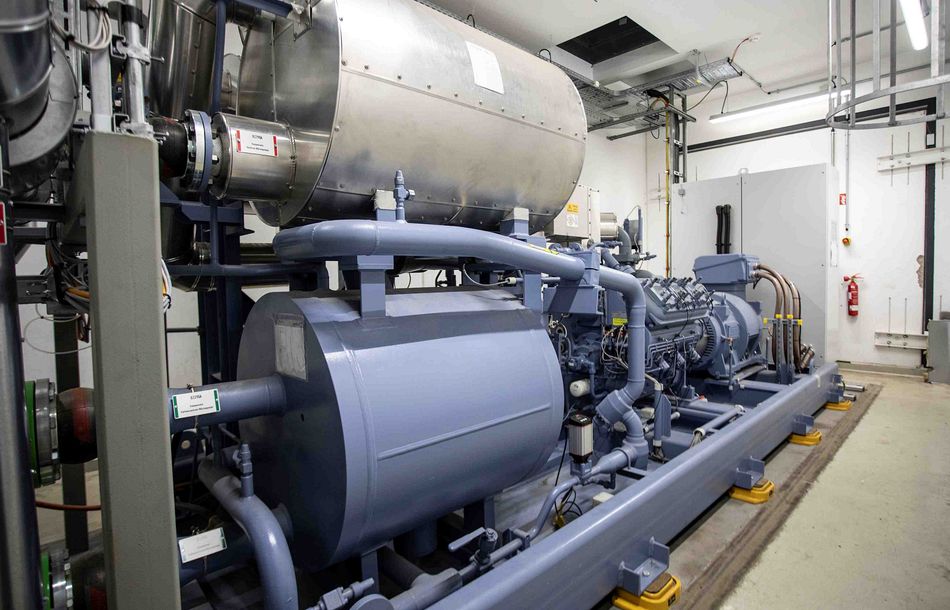By supplying two large heat pumps for the Neukölln district heating plant (FHW), Gea is supporting the climate-friendly generation of district heating for households in the Berlin districts of Neukölln and Kreuzberg. The 8.5-tonne systems are not only at the heart of the heating transition at FHW Berlin-Neukölln, but are also a key component of the nationwide research project “Real-world laboratory of the energy transition”, initiated by the German government and financially supported by the Federal Ministry for Economic Affairs and Climate Protection.
As part of this project, large heat pumps will be installed in Stuttgart, Mannheim and Rosenheim in addition to Berlin and tested in real operation until March 31, 2026. Energy suppliers and scientific institutes from all over Germany are researching the practical suitability, potential and application conditions of large heat pumps in district heating networks under the umbrella of the Arbeitsgemeinschaft Fernwärme (AGFW, now the Efficiency Association for Heating, Cooling and Combined Heat and Power). The data and findings obtained are intended to accelerate the heating transition and will be shared among the partners.
Heat generation at the Berlin-Neukölln district heating plant
Heat is generated at the Weigandufer site of the Berlin district heating plant. This is provided by seven large boilers using wood pellets, heating oil and natural gas. Hard coal is no longer used. To achieve the heat transition, five combined heat and power plants on the FHW site efficiently produce heat and electricity using combined heat and power (CHP). This combined generation process enables a particularly high degree of fuel utilization.
A large Gea heat pump is already connected to the five combined heat and power plants. It uses the waste heat from the charge air cooling of the highly efficient combined heat and power plants. This increases the efficiency of the overall system by around five percent. This means that an additional 4,000 megawatt hours of heat can be generated per year for the neighborhood from waste heat that would otherwise be lost.
Another new “hydrogen-ready” combined heat and power plant with GEA large heat pump soon to go into operation
Another new combined heat and power plant will soon go into operation on the site of the Berlin CHP plant. The new combined heat and power plant is “hydrogen-ready”.
25,000 tons of CO₂ to be saved from 2025
FHW Berlin plans to continuously invest in the heat transition. To this end, the heat generation systems are being replaced with new, environmentally friendly systems and renewable energy sources are being integrated during ongoing operations. This includes more flexible combined heat and power plants, power-to-heat and a second heat storage facility. This will reduce the FHW’s CO₂ emissions by 25,000 tons per year from 2025. FHW Berlin also wants to offer local companies in which combustion and heating processes take place the opportunity to feed industrial waste heat into the FHW district heating system.
How the heat reaches the households
The heat reaches the connected households in the form of hot water – there are around 55,000 of them in the Neukölln and Kreuzberg districts. The water releases its heat and flows back to the FHW Neukölln in a circulation system. Around 120 kilometers of pipes have now been installed. Around two to four kilometers are added every year. The district heating network now extends from the Landwehrkanal in Kreuzberg via Grenzallee in Neukölln, Reuterkiez and Körnerpark to Tempelhofer Feld in Oderstraße.
Two RedGenium heat pumps
The company is supplying a total of two large heat pumps for the FHW Neukölln. The RedGenium is a highly efficient ammonia heat pump with Grasso reciprocating compressor, evaporator with integrated liquid separator and all heat exchangers as fully welded plate heat exchangers. The factory-assembled and ready-to-connect unit is equipped with a frequency converter as standard. The RedGenium heat pump in conjunction with the brand new Gea Grasso V XHP reciprocating compressor enables temperatures of +95 °C to be provided.
In addition to the temperature increase, the largest V XHP compressor also offers almost double the capacity compared to the previous models available on the market. The new V XHP reciprocating compressor series thus sets new standards. The new GEA solution ideally complements the existing heat pump portfolio, as it is ideally suited for many processes with high heat load requirements. These are, for example, applications in the food, beverage and dairy industries. The temperature level also meets the criteria for space heating, district and local heating networks.
Efficiency in the +95 °C class
Electrically driven heat pumps are able to replace conventional heating systems based on fossil fuels. They use either available process waste heat or other heat sources from the environment and transfer the heat to a high temperature level. Even when using pure “coal power”, for example, a heat pump’s efficiency makes it more sustainable than conventional boilers, according to the company, as they only require around a third of the primary energy of a boiler to deliver the same output.
Watch a video here: Gea RedGenium heat pump
Source: Gea






